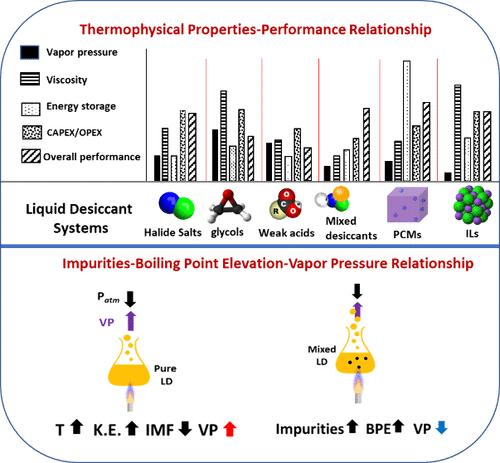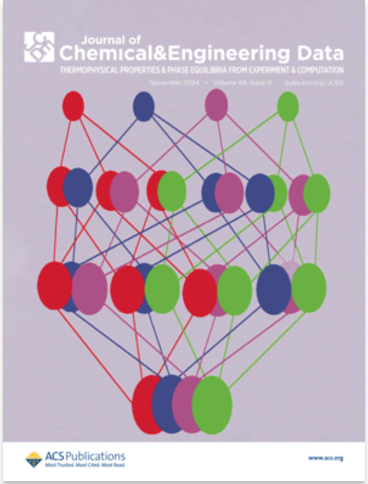暖通空调应用液体干燥剂的热物理性质和最新发展趋势综述
IF 2.1
3区 工程技术
Q3 CHEMISTRY, MULTIDISCIPLINARY
引用次数: 0
摘要
液体干燥剂空调(LDAC)系统的设计及其除湿和再生性能在很大程度上取决于液体干燥剂(LD)溶液的热物理性质。选择合适的 LD 主要取决于其蒸汽压,但其他特性(如粘度、密度、比热容、资本/运营成本等)也同样重要,应仔细评估。纯 LDs,如乙二醇(如三甘醇 (TEG) 和聚乙二醇 (PEG))、卤化物盐(如 LiBr、LiCl、CaCl2 和 MgCl2)和弱有机酸盐(如 HCO2K/Na、CH3CO2K/Na),具有不同的除湿和再生性能,这是由热物理性质的差异决定的。卤化盐基液体干燥剂目前最受欢迎,因为它们具有良好的热力学特性和低挥发性。然而,这类材料可能会受到吸收效率低、结晶问题和成本高的限制。相反,混合干燥剂溶液(如 LiCl-CaCl2、LiBr-CaCl2、LiCl-PEG 等)的特点是蒸汽压较低、除湿效率较高、材料成本和能源需求较低。混合干燥剂溶液热物理性质的改善可能与基质中存在杂质所带来的 "沸点升高 "现象有关。尽管在暖通空调应用方面的研究有限,但离子液体(ILs)提供了一种潜在的卤化盐替代品,可以解决与传统 LD 溶液相关的缺点。特别值得关注的是基于相变材料(PCM)的 LD,它代表了 LDAC 技术的新方向。PCM-LD 的特点是:(1)由于 PCM 颗粒的 "沸点升高",热性能得到改善;(2)由于 PCM 的温度控制能力,再生要求降低。本研究比较了常见 LD 解决方案的热物理性质(如蒸汽压、密度、粘度和比热容)和成本,并回顾了替代液体干燥剂解决方案的最新发展趋势。由于混合干燥剂系统具有改善除湿特性的潜力,同时又能解决资本和运营成本问题,因此激发了人们的研究兴趣。本文章由计算机程序翻译,如有差异,请以英文原文为准。

A Review of the Thermophysical Properties and Recent Development Trends on Liquid Desiccants for HVAC Applications
The design of a liquid desiccant air conditioning (LDAC) system and its dehumidification and regeneration performance are significantly determined by the thermophysical properties of the liquid desiccant (LD) solution. The selection of a suitable LD depends largely on its vapor pressure, although other properties (e.g., viscosity, density, specific heat capacity, capital/operational cost, etc.) are equally important and should be carefully evaluated. Pure LDs, such as glycols (e.g., triethylene glycol (TEG) and polyethylene glycol (PEG)), halide salts (e.g., LiBr, LiCl, CaCl2, and MgCl2), and weak organic acid salts (e.g., HCO2K/Na, CH3CO2K/Na) have variable dehumidification and regeneration performances, as determined by the differences in thermophysical properties. Halide salt-based liquid desiccants are currently the most popular because they possess good thermodynamic properties and low volatility. However, such materials may be limited by low absorption efficiency, crystallization issues, and high cost. On the contrary, mixed desiccant solutions (e.g., LiCl-CaCl2, LiBr-CaCl2, LiCl-PEG, etc.) are characterized by lower vapor pressures, better dehumidification efficiency, and lower material cost and energy demands. The improved thermophysical properties of mixed desiccant solutions may relate to “elevation of boiling point” phenomenon imparted by the presence of impurities in the matrix. Ionic liquids (ILs) offer a potential alternative to halide salts and can address the drawbacks associated with conventional LD solutions, despite limited research in HVAC applications. Of particular interest are phase change material (PCM)-based LDs which represent a new direction in LDAC technology. PCM-LDs are characterized by (1) improved thermal properties due to “elevation of boiling point” by the PCM particles, and (2) lower regeneration requirements due to temperature control ability of the PCMs. This study compares the thermophysical properties (e.g., vapor pressure, density, viscosity, and specific heat capacity) and cost of common LD solutions and reviews recent development trends on alternative liquid desiccant solutions. Hybrid desiccant systems have stimulated significant research interest because of their potential to improve the dehumidification characteristics while addressing capital and operational costs.
求助全文
通过发布文献求助,成功后即可免费获取论文全文。
去求助
来源期刊

Journal of Chemical & Engineering Data
工程技术-工程:化工
CiteScore
5.20
自引率
19.20%
发文量
324
审稿时长
2.2 months
期刊介绍:
The Journal of Chemical & Engineering Data is a monthly journal devoted to the publication of data obtained from both experiment and computation, which are viewed as complementary. It is the only American Chemical Society journal primarily concerned with articles containing data on the phase behavior and the physical, thermodynamic, and transport properties of well-defined materials, including complex mixtures of known compositions. While environmental and biological samples are of interest, their compositions must be known and reproducible. As a result, adsorption on natural product materials does not generally fit within the scope of Journal of Chemical & Engineering Data.
 求助内容:
求助内容: 应助结果提醒方式:
应助结果提醒方式:


